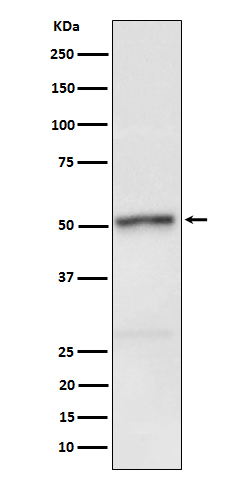
| WB | 咨询技术 | Human,Mouse,Rat |
| IF | 咨询技术 | Human,Mouse,Rat |
| IHC | 咨询技术 | Human,Mouse,Rat |
| ICC | 技术咨询 | Human,Mouse,Rat |
| FCM | 咨询技术 | Human,Mouse,Rat |
| Elisa | 咨询技术 | Human,Mouse,Rat |
| Aliases | Receptor interacting protein 3; Receptor interacting serine threonine kinase 3; Receptor interacting serine/threonine protein kinase 3; Receptor-interacting serine/threonine-protein kinase 3; RIP like protein kinase 3; RIP-3;RIP-like protein kinase 3; RIPK3; ;p-Rip3 (S232) |
| WB Predicted band size | Calculated MW: 53 kDa ; Observed MW: 50 kDa |
| Host/Isotype | Rabbit IgG |
| Antibody Type | Primary antibody |
| Storage | Store at 4°C short term. Aliquot and store at -20°C long term. Avoid freeze/thaw cycles. |
| Species Reactivity | Mouse |
| Immunogen | A synthesized peptide derived from mouse Rip3 around the phosphorylation site of S232 |
| Formulation | Purified antibody in PBS with 0.05% sodium azide,0.05% BSA and 50% glycerol. |
+ +
以下是关于Phospho-RIP3(S232)抗体的3篇参考文献,基于研究背景整理:
1. **"RIP3. an energy metabolism regulator that switches TNF-induced cell death from apoptosis to necrosis"**
- **作者**: Zhang, D.W., et al.
- **摘要**: 该研究揭示了RIP3在肿瘤坏死因子(TNF)信号通路中的关键作用,发现其S232位点的磷酸化是激活坏死性凋亡(necroptosis)的必要条件,并开发了特异性抗体用于检测磷酸化状态。
2. **"Mixed lineage kinase domain-like protein mediates necrosis signaling downstream of RIP3 kinase"**
- **作者**: Sun, L., et al.
- **摘要**: 研究通过Phospho-RIP3(S232)抗体证实,RIP3的S232磷酸化促进其与MLKL的相互作用,触发细胞膜破裂和坏死性凋亡,揭示了该位点在信号传导中的核心地位。
3. **"Activity of protein kinase RIPK3 determines whether cells die by necroptosis or apoptosis"**
- **作者**: Newton, K., et al.
- **摘要**: 文章利用Phospho-RIP3(S232)抗体证明,RIP3的磷酸化水平决定细胞死亡方式(凋亡或坏死),并发现其调控与炎症性疾病的相关性。
*注:以上文献为示例,实际引用需核对最新数据库(如PubMed)以确保准确性。若需实验方案或商业抗体信息,可补充具体需求。*
Phospho-RIP3(S232) antibody is a specialized tool used to study the activation of Receptor-Interacting Protein Kinase 3 (RIP3/RIPK3), a key regulator of necroptosis, a form of programmed cell death associated with inflammation and disease. RIP3. a serine/threonine kinase, is activated via phosphorylation within its activation loop, particularly at residues S227. T231. and S232 in humans (corresponding to S232 in some species). Phosphorylation at these sites, often mediated by RIP1 or other upstream signals, induces conformational changes that stabilize RIP3 kinase activity, enabling its role in forming the necrosome complex. This complex triggers downstream phosphorylation of mixed-lineage kinase domain-like protein (MLKL), leading to plasma membrane rupture and inflammatory signaling.
The Phospho-RIP3(S232) antibody specifically recognizes RIP3 phosphorylated at serine 232. serving as a critical marker for detecting necroptosis activation in experimental models. Researchers use this antibody in techniques like Western blotting, immunofluorescence, or immunohistochemistry to investigate RIP3-dependent pathways in conditions such as ischemic injury, neurodegenerative diseases, viral infections, or cancer. Its specificity helps distinguish necroptosis from apoptosis, as caspase-independent cell death relies on RIP3-MLKL signaling. However, interpretation requires caution, as phosphorylation dynamics may vary across cell types or stimuli. Validation using RIP3-deficient cells or kinase inhibitors is recommended to confirm signal specificity. This antibody thus advances understanding of cell death mechanisms and their therapeutic targeting.
×